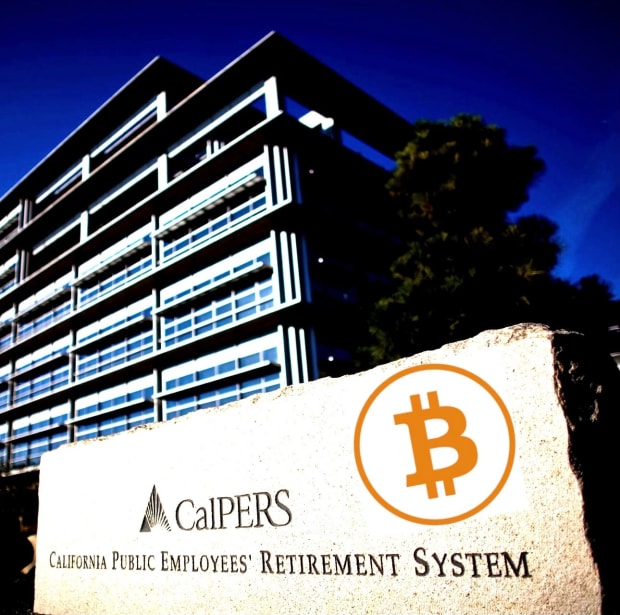[ad_1]
This is an opinion editorial by Dom Bei, the former Santa Monica Firefighters Union president.
Author’s note: Pension issues have been in and out of the media for decades. My own background and perspective on these issues come from over a decade of experience as an executive board member for my local firefighter’s union. Additionally, I sat on my municipality’s pension advisory board, where I learned the fundamentals of pension funds. This is a complex issue, but one worthy of our time and attention due to its significance in the global financial system and the lives of our workforce.

What if I told you that the largest pension fund in the United States could be rescued by Bitcoin? Furthermore, what if it could happen in a way that maintains 100% of its primary portfolio investments in traditional markets? I know. For those who don’t “Bitcoin,” many of you will stop here. But I urge you to read on a bit further. And for those who do Bitcoin, there is likely a pension near you facing a similar dilemma.
By incorporating bitcoin into the California Employers Pension Prefunding Trust Fund (CEPPT), California could continue to deliver on its commitment to its workforce and retirees, without having to make employees work longer years while paying more into the California Public Employees’ Retirement System (CalPERS) fund. Additionally, if California doesn’t want to do this, municipalities could and should do it on their own regardless by funding what I call a “Bitcoin Municipal Employers Pension Prefunding Trust (MEPPT).” In doing so, cities and public agencies could escape the redundant fate of unfunded liability payments.
Why bitcoin? Unlike other assets, “Bitcoin has no risk of liquidation,” as explained by Mickey Koss in a recent article, “Pension Funds Must Adopt Bitcoin or Risk Insolvency.” “Bitcoin does not require leverage. Instead of making risky bets, perpetuating the culture of moral hazard and socialized losses, pension funds can use bitcoin as an asymmetric opportunity in order to bolster their returns.”
The CalPERS Crisis
With a total value of roughly $440 billion dollars, CalPERS is the largest “defined benefit” public pension in the nation, and fifth-largest public pension in the world as of 2022. Holding in its hands the financial fates of public employees, municipalities and public agencies in California, CalPERS’ main priority is to grow and maintain its fund. By doing so, it can deliver on its commitments, which are payments to retirees.
The funded status of any pension takes the form of a percentage. It is the total estimated value of the assets on hand as a percentage of the total obligation to pay retirees (its liabilities). As reported most recently in June 2022, CalPERS holds an estimated funded status of 72%. This is below the traditionally accepted “healthy” funded status which is at least 80%. Most simply, this means that the fund currently has the ability to liquidate its assets to obtain 72% of the funds needed to make all of its payments. Thus, 28% of its overall liabilities are unfunded.
California has a larger unfunded pension liability than any other state in the nation. A report released earlier last year by the American Legislative Exchange Council (ALEC), found that unfunded pension liabilities nationwide have climbed to $8.28 trillion, “or just under $25,000 for every man, woman and child in the United States,” with California holding the nation’s largest public pension debt load.
CalPERS’ unfunded pension liability comes on the tail end of major pension reform in 2013. The reform extended the retirement age of new employees and increased employee contributions into the fund. Additionally, the fund benefited from a massive injection of liquidity in the past few years.
Governor Newsom’s 2022 to 2023 “Governor’s Budget Summary” noted that “from 2017-18 through 2021-22, the state has made supplemental pension payments of $12.7 billion to CalPERS and CalSTRS (the California State Teachers Retirement System), with the goal of improving the funded status of both systems and reducing the state’s long-term retirement obligations.”
Despite both of these efforts over the past decade, a sustained improvement in CalPERS’ funded status has not arrived. On the eve of the next reporting period, all eyes are on the funded status and unfunded liability report that should arrive in June 2023. Fingers crossed.
Unfunded Liabilities And Their Impacts
An unfunded liability, quite simply, is the amount owed to keep a pension fund on pace to meet its obligations. Unfunded liabilities lead to extra payments, on top of the regular, annually-required payments to the pension, made by municipalities and public agencies. If you are scratching your head at this point, that’s normal. Pensions are complex with tons of variables, including the number of active employees/retirees, predicted life expectancy of retirees, cost-of-living adjustments, portfolio performance and more.
Unfunded liabilities don’t just disappear. They force CalPERS to request additional payments from municipalities and public agencies, on top of the normal payments made by those cities and agencies, as well as the contributions made by the employees into the pension fund.
These “extra” payments take a significant toll on cities. If unpaid, they accrue interest, and become looming burdens. I learned this after sitting on the pension advisory committee in my own city — a city with a long tradition of having an incredible public workforce. High-quality employees are so important. While this view is widely accepted in the private sector, it isn’t always so in the public sector. But some of the best-run and highest-revenue-earning cities understand and prioritize this. A dedicated public workforce is a tremendous benefit for the citizens of a city and visitors who receive city services. In the field of emergency services, that level of service can be the difference between life and death.
When municipalities have to pay unfunded liabilities on top of their normal pension payments, they either have to be extremely well off, or take away services from somewhere else to make the payments.
But luckily, we have an opportunity to escape this dilemma.
How Bitcoin Can Fill The Unfunded Gap
Enter Bitcoin. Bitcoin is an innovation with increasing global adoption, use and value. While the price has fluctuated greatly since its inception, Bitcoin’s network and community trajectory has outpaced many comparable technological revolutions in their early years. That includes the internet, cell phones and other major technological breakthroughs. Additionally, as an asset, when zooming out, its performance trends up.
Despite its upward trajectory, Bitcoin is still new and, therefore, turbulent and constantly adapting. It also has yet to be clearly defined by the legacy financial system and regulatory agencies, providing barriers to entry.
CalPERS could add bitcoin to its balance sheets. But an easier, more realistic course of action would be to utilize a tool it already created: the CEPPT.
The CEPPT is a separate, “Section 115 trust fund dedicated to prefunding employer contributions to defined benefit pension systems for eligible California public agencies.” Think of it as a side fund to cover the shortfalls of the main fund. The flaw with the current, non-Bitcoin CEPPT, is that the fund is based in the same system that brought about the need for a new side fund to begin with. Eventually, that fund will succumb to the same structural vulnerabilities as the CalPERS main pension portfolio. And then what? A pre-, pre-funding trust to pay the pre-funding trust?
CalPERS’ CEPPT webpage says that, since its inception, “more than 75 California public employers” are participating. My recommendation: Pivot, or if you are an elected city official, reconsider this strategy. Instead, establish a Bitcoin MEPPT.
The long-term returns of bitcoin represent the only asset class that can fill the holes, currently un-fillable, in the CalPERS pension fund. The cities that implement this will find themselves the beneficiaries of a healthy workforce and financial stability. They will bypass the painful dilemma of cutting key services to taxpayers in order to pay endless unfunded liabilities. They can avoid downgrading their workforce to the point that they are unable to recruit and retain high-quality personnel.
Bitcoin CEPPT Or MEPPT: Easy First Step And Added Benefits
With a Bitcoin CEPPT or MEPPT, public employers, cities, employees and CalPERS can safely enter the world of Bitcoin without moving funds out of its portfolio, which we know is very difficult.
A Bitcoin CEPPT run by the state could free California from its value-based investment dichotomy. That dichotomy: being a state that simultaneously funds and prioritizes renewable energy, while condemning yet financially supporting fossil fuels and big oil through its roughly $42 billion investment. The largest public fund investor of fossil fuels in the U.S. is CalPERS. It truly has one foot into the future while propping up the past.
A Bitcoin CEPPT could also include infrastructure components. A potential structure could allow California to further tap its abundant and steady renewable energy, providing Bitcoin miners an opportunity to become even more climate friendly than they already are. In fact, a majority of Bitcoin mining captures either wasted energy sources or renewable energy. Bitcoin miners that have proven useful as a grid-balancing partner, could take the place of household energy consumers in California during times when the power is often shut off, such as during its frequent red-flag warning, fire-weather days. During these times, Southern California Edison is forced to balance the grid and shut off power to peoples’ homes.
In these ways, and many more unmentioned ones, Bitcoin is a far better partner for California’s renewable energy goals, then the big oil and fossil fuel Industry, currently capturing $42 billion, nearly 10% of CalPERS invested money!
For other states with similar issues, there are many exciting ways in which a Bitcoin CEPPT or MEPPT could be configured. There is even a tool called “Nakamoto Portfolio,” which was developed by Raphael Zagury, the CIO of Swan Financial. This tool allows funds to explore different configurations of how bitcoin could positively affect their portfolios based on past and predicted performances.
Despite its volatility, many legacy financial institutions predict the long-term value of bitcoin will continue to rise. Fidelity has even called for 1 Bitcoin to be valued at $1 million dollars by 2038. That’s conservative, among some other long-term predictions. Many have compared Bitcoin to Apple, however it is much more than Apple. Apple changed the way in which the world interacts with technology. Bitcoin is simply going to change the world, and for the better and in ways we have yet to imagine.
In the likely event that Bitcoin is here to stay, this is a vehicle in which CalPERS can responsibly and slowly enter into the world of Bitcoin. Who knows, perhaps a Bitcoin CEPPT could prove worthy of primary portfolio contributions, to a point where it takes on a greater portion of CalPERS funds?
I’d like to see both ride off together into the California sunset: The CalPERS fund and Bitcoin CEPPT, giving California options to invest in ways truer to its core values, while supporting a vibrant and committed workforce.
To the cities and agencies who scoff at the idea of a Bitcoin CEPPT or MEPPT, I ask you an important question: If not Bitcoin, then what’s the plan to avoid bankruptcy or a declining workforce in your city due to runaway unfunded liabilities? To the unions and workers, how much longer are you willing to work and for how much less money, until we become more involved in the oversight of our own pension funds? And to CalPERS and the California legislature, you have a fiduciary obligation to those workers who built our state, to protect their funds and futures. Without another plan, cities, public employers and states owe it to the taxpayers and employees to explore Bitcoin and its promising future.
I am eager and happy to work with any union, city or elected official in the state to explore this as an option, at no cost. Why? Because I care about workers. As a firefighter and union leader, I’ve worked alongside a committed and amazing workforce, and I believe that when humans commit their most precious years to building something for their cities and states, they deserve the retirement that was promised on signup day.
This is a guest post by Dom Bei. Opinions expressed are entirely their own and do not necessarily reflect those of BTC Inc or Bitcoin Magazine.
[ad_2]
Source link
My NEO Group:
– White paper My NEO Group: https://myneo.org
– Discover NEO X: https://docs.myneo.org/products/in-development/neo-x
– Disccover NEO Dash: https://myneodash.com
– Discover Banca NEO: https://bancaneo.org
– Interview of the CEO of My NEO Group, Mickael Mosse, in Forbes: https://forbesbaltics.com/en/money/article/mickael-mosse-affirms-commitment-to-redefining-online-banking-with-bancaneo






